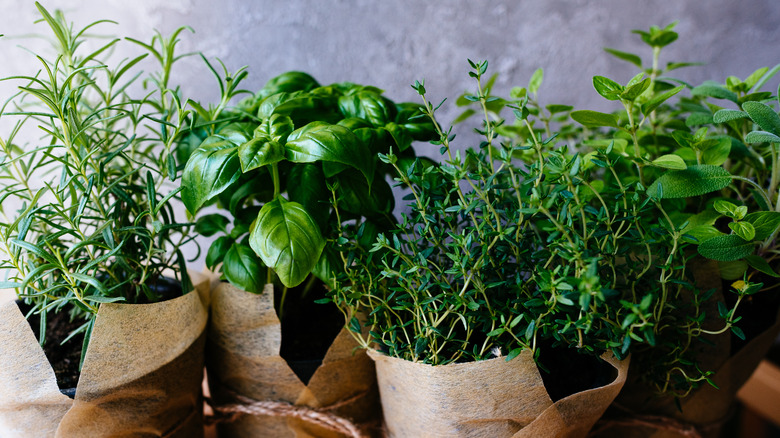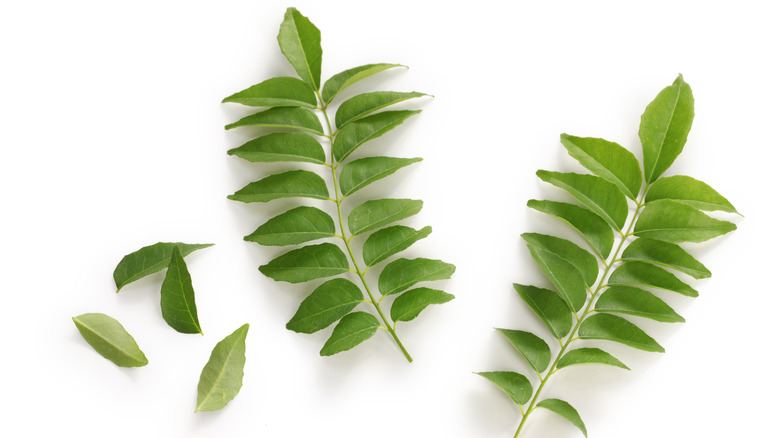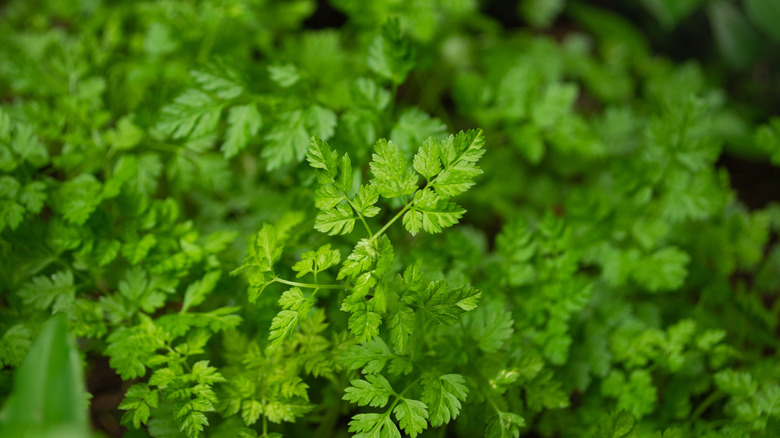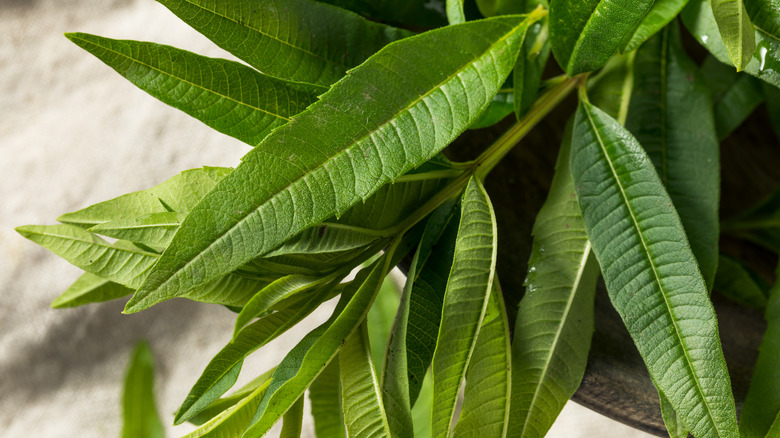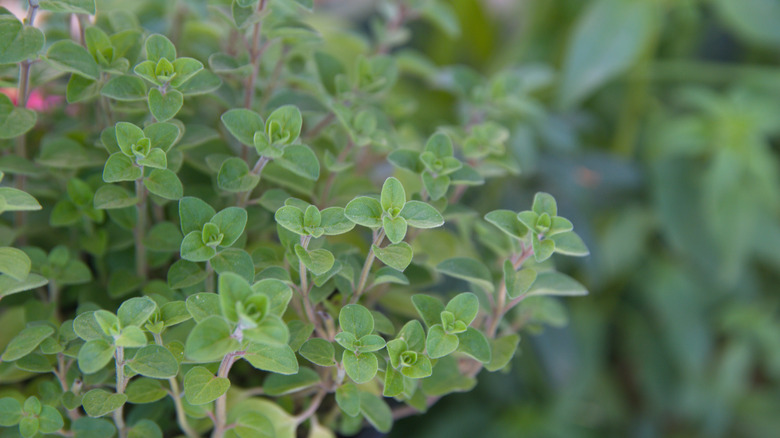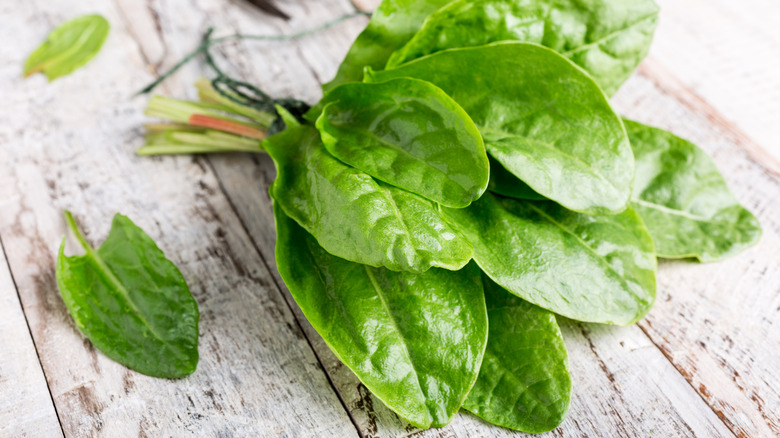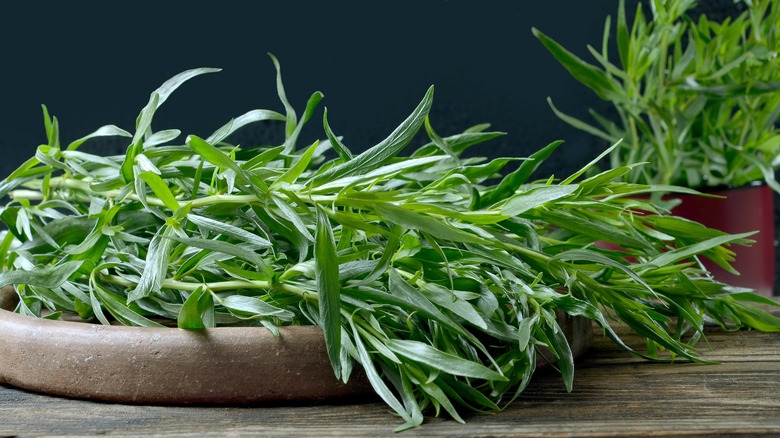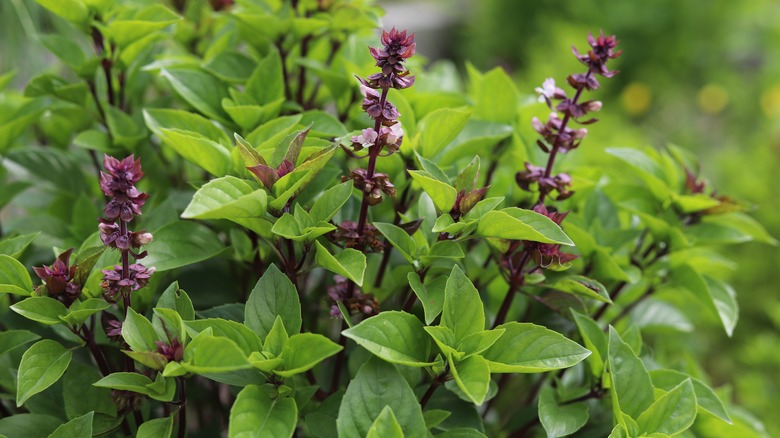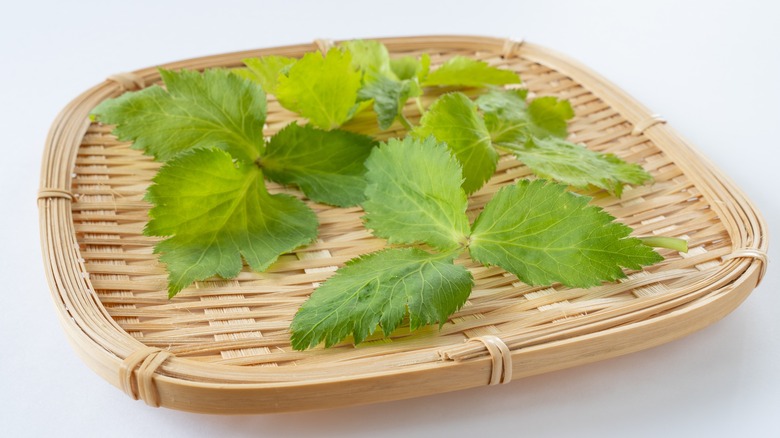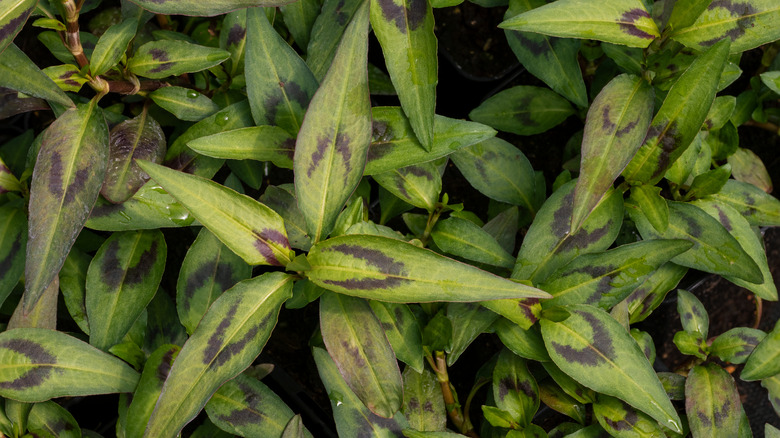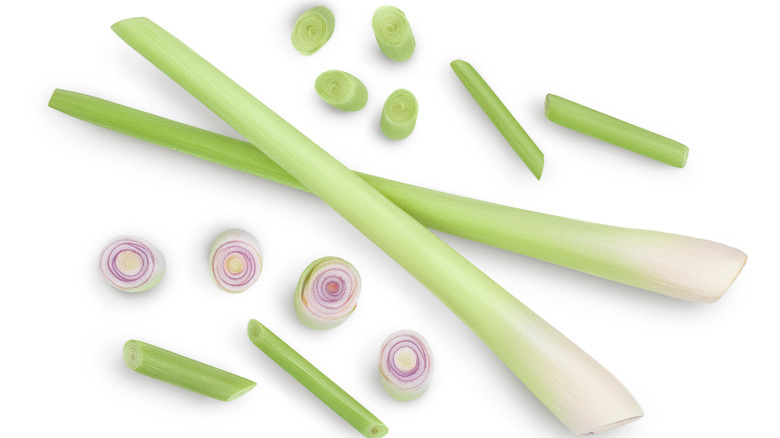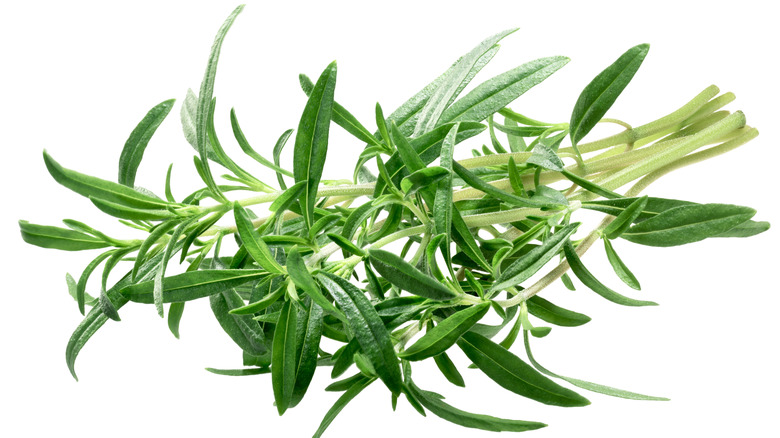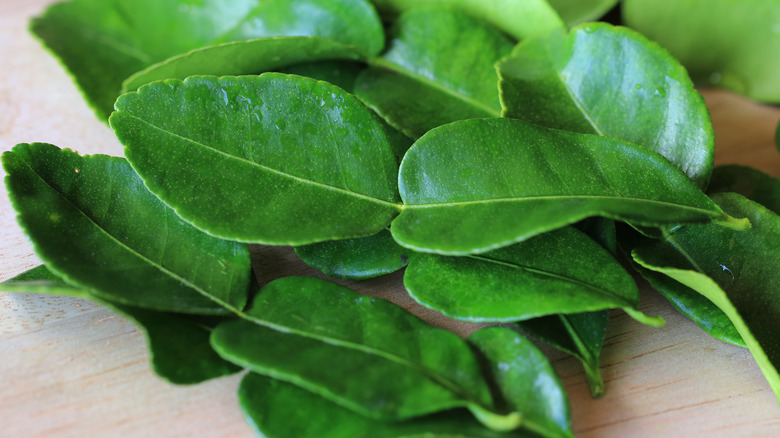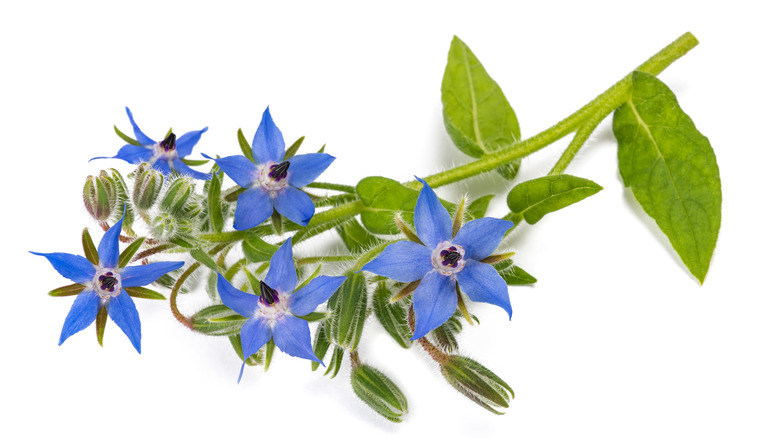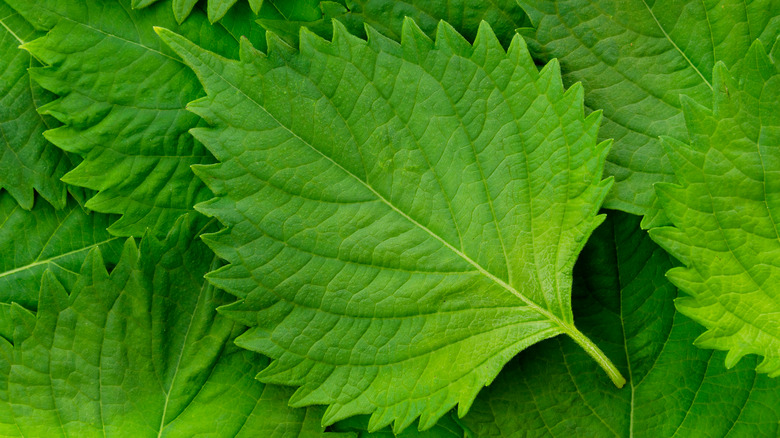14 Underrated Types Of Herbs You Should Be Cooking With More Often
If you consider yourself to be an individual who is comfortable in the kitchen, it's likely that you've used herbs in your cooking at some point. According to Masterclass, herbs are fragrant, edible plants with leaves that are used to season and garnish food. This is opposed to spices, which are defined by the McCormick Spice Institute as flavoring agents derived from any part of a plant other than its leaves.
Herbs often enliven dishes with their fresh and vibrant flavors, and are used in cuisines around the world. They not only contribute flavor, but are also nutritious and highly beneficial to health. Greatist states that herbs are often packed with vitamins and antioxidants, and many have anti-inflammatory and breath-freshening properties as well.
As mentioned, herbs appear in dishes from across the globe, and there is an impressive variety that differs based on what region of the world you're in. Thanks to globalization and the ability to keep fresh food refrigerated during the import process, we now have access to an increasing number of ingredients from different cuisines. While popular herbs like rosemary, oregano, and sweet basil remain firm favorites, there is an exciting world of lesser-known herbs that can add new flavors to your cooking. Here are 14 underrated herbs that you should be cooking with more often.
1. Curry Leaves
Despite their namesake, curry leaves are not an ingredient found in curry powder. They are glossy, bright green leaves with a pungent, citrusy flavor reminiscent of lemon zest and anise. This herb is commonly used in South Indian and Southeast Asian food, where you can find them in curries, sauces, and snacks.
The best way to extract flavor from curry leaves is to fry them in oil or ghee, as boiling them often subdues their aroma. Chef Niven Patel explains to Food & Wine that in South Indian cuisine, curry leaves are often fried in hot oil with cumin and mustard seeds to infuse the oil. Called tadka or vagar, this oil is used for cooking or is stirred into dals, curries, and chutneys to impart the unique fragrance and flavor of curry leaves and other spices to the dish. Chef Patel also recommends using curry leaf-infused oil to make a vinaigrette to drizzle over salad greens, cucumbers, and tomatoes. Additionally, instead of throwing out the leaves after frying them in oil, crush them into small pieces — they will be brittle and crispy after frying — and scatter them over french fries or popcorn. Curry leaves can be found in Indian or Southeast Asian grocers, and are best used fresh.
2. Chervil
Feathery and delicate, chervil's lace-like appearance makes it a popular garnish in France, and its flavor, a mix of parsley and anise, is also enjoyed as a seasoning, per The Art of Eating. It is one of the four herbs that make up fines herbes, a traditional French herb blend suited to use with egg and poultry — the other three herbs are tarragon, parsley, and chives. According to Chef Hugh Fearnley-Whittingstall (via The Guardian), chervil was known as the 'happy herb' to the Greeks, a sentiment that is shared by later European folklore, which believed that chervil aided in digestion and raised spirits and intelligence.
Chervil is best used fresh, chopped finely, and added in at the last second of cooking, as long periods of cooking destroy its flavor. It can be stirred into creamy soups, scattered over salads, and used in herb butters and cream sauces. The Art of Eating suggests pairing chervil with seafood, eggs, and vegetables like carrots, peas, and tomatoes.
You may find fresh chervil at the refrigerated herb section of large supermarkets, or at farmers' markets in the spring. Take care with storing fresh chervil for long periods, as they absorb off-flavors from the fridge and lose their aroma easily, despite no change in their external appearance.
3. Lemon Verbena
Lemon verbena, or verveine, is a shrub with long, pointed leaves that are prized for their flavor that is similar to lemon zest with herbaceous notes. It is one of the seven must-have herbs that Chef Jeremy Gillion uses at his Michelin-starred restaurant JAG, where he uses it to add complexity to soups and stocks, and an edge of bitterness to sweets (via MICHELIN Guide).
With its citrusy fragrance, lemon verbena is most commonly used in sweet applications, such as ice creams, cakes, and drinks. It can be infused into simple syrup for use in cocktails and iced drinks, or to be brushed or drizzled onto cakes. The flavor of lemon verbena can also be easily distilled into other neutral bases. Insert several sprigs of the herb into a tall bottle of vinegar or oil, and use the infused product in vinaigrettes, marinades, or as accompaniments to fresh bread. You can also crush fresh lemon verbena leaves and add them to sugar, or pulse dried leaves with sugar in a food processor to make a delightful flavored sugar. Fresh lemon verbena may be found at farmers' markets, but dried versions are more easily available at spice stores or in the form of tea.
4. Marjoram
With its small stature and tiny oval leaves, marjoram is often mistaken for its more well-known cousin oregano. The Herb Society of America states that while there are similarities in the flavors of both herbs, marjoram has a sweeter and milder flavor with more delicate woody and floral notes, compared to oregano's pungent and grassy aroma.
Marjoram is one of the herbs found in herbes de Provence, an all-purpose herb mix that originated in the south of France and traditionally also contains basil, tarragon, oregano, thyme, summer savory, rosemary, and fennel seeds (via Masterclass). Add fresh or dried marjoram to marinades for meat, tomato sauces, soups, and roasted vegetables.
In addition to herbes de Provence, you can also use marjoram to make your own za'atar, a Middle Eastern spice blend that you can sprinkle on practically everything. Grind toasted sesame seeds, and mix with a blend of thyme, marjoram, oregano, sumac, and salt, and use the mixture as a dry rub, stir it into dips, or mix it with olive oil as a dip for bread. Marjoram can be found at the fresh herb section or spice rack at most grocery stores.
5. Sorrel
The New York Times states, "In France, sorrel is a familiar sign of spring," and it's not hard to see why. With verdant green leaves in the shape of a spade and a bright lemony flavor, sorrel presents a marked change from the stodgy comfort foods of winter.
Sorrel is unique in the way it can be used as both a herb and as a leafy green. It can be rolled up into cylinders and sliced into thin ribbons — also known as a chiffonade – and then scattered over salads and stews, or wilted in a pan and cooked with cream like spinach. You can use it as a salad green, in soup, or combined with spinach and blended into a pesto.
Writing for The Guardian, Chef Hugh Fearnley-Whittingstall sings the praises of sorrel, and highlights its ability to add a layer of complexity and acidity to delicately-flavored or creamy dishes. He recommends pairing sorrel with a variety of ingredients, including eggs, chicken, potatoes, Crème Fraîche, and legumes. Keep a lookout for sorrel at farmers' markets in the early days of spring to early summer when the leaves are at their best, as they start to become bitter later in the year (via Masterclass).
6. Tarragon
You would be hard pressed to find another herb with a name as impressive as tarragon. According to The Culinary Institute of America, tarragon, with its long and slender leaves that taste of anise and vanilla, is revered as "The King of Herbs" in France. The Washington Post explains that its Italian name — dragoncello — is a reference to its medieval name, back when it was called the dragon herb.
As the country's King of Herbs, tarragon is found throughout French cooking. It is a component of two traditional herb mixes used in French cuisine, fines herbes and herbes de Provence, and is used to flavor béarnaise sauce. It can be used in salad dressings like Green Goddess, infused into vinegar, or simply added into salad greens. Finely minced, it can be added to condiments like mayonnaise, aioli, or sour cream as an easy way to add flavor and take ordinary kitchen staples to another level. Tarragon can be found at most supermarkets in both fresh and dry versions, but dried tarragon often loses its aroma and flavor quickly.
7. Thai Basil
If you've ever had pad krapow, a spicy stir fry made with ground meat or seafood, at your favorite Thai restaurant, you would have come across leaves that taste like licorice and mint. That would be Thai basil, and alongside fish sauce and bird's eye chili, this herb is what gives pad krapow its signature flavor.
Native to Southeast Asia, Thai basil is also used in Vietnamese, Laotian, and Cambodian cuisine. Its leaves are smaller than the more common sweet basil, and have serrated edges and purple stems. According to America's Test Kitchen, Thai basil leaves are also more tolerant to cooking, and can be added to your dish during the cooking process instead of at the end. Add Thai basil to stir fries and curries, or use them raw in salads and Vietnamese summer rolls. Alternatively, chiffonade your leaves or tear them roughly and add them to noodle soups like you would do for pho. In recipes that call for regular fresh basil, replace it with Thai basil to provide an interesting twist to classic recipes. Thai basil is usually only sold fresh, and you can find it at a well-stocked supermarket or Asian grocer that specializes in Thai or Southeast Asian products.
8. Mitsuba
Mitsuba, and its English name trefoil, means "three leaf," which is in reference to the leaves' distinctive pattern of growing in clusters of three. According to Japanese cookbook author Namiko Hirasawa Chen, mitsuba is eaten to bring good luck, and is often found in dishes served at celebrations like New Year's day and weddings (via Just One Cookbook).
It is a refreshing and mild herb that has notes of celery and parsley, and both the leaves and tender stems are often used as a garnish scattered over a dish before serving. The flavor of mitsuba often disappears or turns bitter when cooked for long periods, and the herb is more commonly used in its fresh form instead of dried. You can find mitsuba on donburi, or Japanese rice dishes, soups, in omelets, and deep fried as tempura. In her book "Herb and Spices The Cook's Reference", Jill Norman recommends eggs, fish, seafood, mushrooms, and root vegetables like carrots and parsnips as good pairings for the flavor of mitsuba. Seek out mitsuba at Japanese grocery stores, and bring some good luck and fresh flavor to your dishes.
9. Vietnamese Coriander
An herb with pointy, slender leaves that sometimes appear with distinctive maroon splotches on its surface, Vietnamese coriander is another popular ingredient in Southeast Asian cooking. According to Jill Norman in "Herb and Spices The Cook's Reference," Vietnamese coriander has a variety of other names. It is also known as Vietnamese cilantro or Vietnamese mint, but the Vietnamese themselves call it rau ram, and in Singapore and Malaysia, it is called laksa leaf or daun kesom.
It has a flavor that is similar to coriander, but more pungent and with notes of citrus, and like coriander, some people may find that it tastes soapy. Vietnamese coriander can be eaten raw, or cooked in soups, curries, and stir fries. You may have encountered it in Thai or Vietnamese salads like larb, or bundled up in rice paper with other herbs in summer rolls. Use it in place of coriander, chop it into shreds for garnishing soups and noodles, or mince and use in pico de gallo or guacamole. Vietnamese coriander is best used fresh, and dry leaves are usually difficult to find. They can be found in most Asian grocers, especially those that carry a variety of Southeast Asian products.
10. Lemongrass
Commonly used in South Asian and Southeast Asian cooking, this tropical member of the grass family is also effective at repelling mosquitoes with its distinctive citrus fragrance, per Horticulture. Its slender, pale green stems are used to impart a lemony-ginger flavor to dishes that range from soups to stir fries and grilled meat.
The stalks of lemongrass are woody and fibrous, and should be bruised with the flat side of a knife or a rolling pin to release its flavor when used whole in soups or stocks, and removed from the dish before serving. To add to stir fries or curries, remove the tough outer layers of the stem, slice the core into thin rounds, and fry it in oil with other aromatics. You can also add minced or grated lemongrass into marinades for grilled meat, or try your hand at Nem Lụi Huế — Vietnamese skewers made of minced pork wrapped around stalks of lemongrass and grilled over charcoal. Lemongrass also lends itself well to sweets and baked goods. Try replacing lemon zest with grated lemongrass in cakes, tarts or pies, or infuse dairy with bruised lemongrass stalks to use in crème brûlée or custards.
Lemongrass can be found at farmers markets, Asian marts, and supermarkets. You may only be able to find frozen lemongrass, which works well and suffers from little loss of flavor. However, steer away from the less flavorful dried lemongrass, which generally only works for use in tea or stocks.
11. Savory
According to The Guardian, the Romans believed that this potent herb was an aphrodisiac and used it in brewing love potions. Due to its connotations, savory was banned in monasteries during medieval times to prevent monks from succumbing to its effects. The savory herb comes in two forms — summer savory and winter savory. While both taste similar to thyme and mint, summer savory is more pungent and peppery, and winter savory has a milder and earthy flavor instead. However, you may have a better chance at finding summer savory, as it is more widely used and accessible.
Summer savory can be used in both fresh and dried forms, and can be used in place of thyme in recipes. Add dried savory to dry rubs and marinades for grilled or roasted meat, or use in stuffing or meatballs. Fresh savory can be infused into vinegar for use in salads and sauces, or cooked with butter, garlic, and parsley as an herb sauce to serve with fish or mushrooms. Masterclass states that savory has benefits related to issues with digestion and bloating, and, as a result, has long been paired with bean dishes. You might be able to find fresh summer savory at the supermarket, and dried savory can be found at spice stores or online.
12. Makrut Lime Leaves
These glossy, dark green leaves shaped like a figure eight have commonly been referred to as "kaffir" lime leaves, but an increasing number of publications and chefs have dropped the term due to its racist connotations in South Africa (via Modern Farmer). Instead, the leaves and fruit of this variety of lime are now referred to by their Thai name, makrut.
Makrut lime leaves have a strong lime flavor with floral notes, and are often used whole like bay leaves to season dishes. You may find entire leaves in curries and soups like Thai Tom Yum, or as fine slivers added to stir fries. Use makrut lime leaves to infuse a variety of recipes that contain large amounts of liquid, from soups and stocks to pickling brine, and in sweet applications like simple syrups and jams. Great British Chefs suggests pairing makrut lime leaves with flavors like lemongrass, ginger, shallots, and chilis, and states that its citrusy notes work especially well with fish and other seafood.
Makrut lime leaves may be found at Thai or Vietnamese grocers in fresh, dried, or frozen form. They freeze quite well, and can be stored for several months before they start to degrade in flavor.
13. Borage
Known throughout history as the herb of courage, Country Living explains that the Druids, Romans, and Greeks all believed that borage granted bravery and comfort. There is even an old wives tale that says putting borage in an unsuspecting suitor's drink would prompt him to propose. The leaves and flowers of borage are both edible, with the oval, gray-green leaves having a refreshing cucumber flavor, and the pretty star-shaped blossoms in pale blue tasting like honey with grassy undertones.
The young leaves of borage can be used as a salad green, or used to flavor soups and stews. Make sauces with vibrant and fresh flavors in the form of borage pesto or chimichurri to serve over pasta or fish. In his book "Cooking with Herbs and Spices," Milo Miloradovich states that borage leaves can be cooked like spinach. In this vein, you can use borage to make ravioli filling, or cook a Cream of Borage soup by cooking and blending the herb with potatoes, cream, and stock. The flowers make an attractive decoration for cakes and sweets, and can be used fresh or candied. Borage might be challenging to find at your local supermarket, and you might be better off looking for it at a farmers market or online.
14. Shiso/Perilla
Shiso or perilla leaves are large, attractive heart shaped leaves with jagged edges and an herbaceous basil-mint flavor. There are two main varieties that are commonly found in Japanese, Korean, and Vietnamese cuisine — green and red. While they taste similar, America's Test Kitchen states that some individuals may be more sensitive to the bitter flavor that is caused by the anthocyanin compounds in red shiso.
You will often find shiso used as a garnish in sushi or sashimi, as the herb has antimicrobial abilities that can reduce the rate of bacterial growth in raw fish and seafood (via Just One Cookbook). The uses of shiso are varied, and you can chiffonade the fresh leaves and add them to salads or cold noodles, eat them in Vietnamese summer rolls, or wrap your grilled meat in the leaves at Korean BBQ. Shiso does not hold up well to being cooked, but slivers of the herb can be stirred into fried rice or noodles at the end of the cooking process to retain its fresh flavor. Dried shiso can be used to season rice and eggs, and is also a common ingredient in furikake, a Japanese seasoning mix that is delicious sprinkled over a variety of dishes. Fresh and dried shiso will be easily available at specialty Japanese and Korean grocers, or well-stocked Asian supermarkets.
